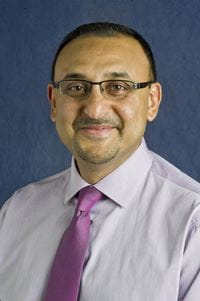Password Reset
Forgot your password? Enter the email address you used to create your account to initiate a password reset.
Forgot your password? Enter the email address you used to create your account to initiate a password reset.
7 Minutes

Satdarshan (Paul) Singh Monga, MD, is the founding director of the Pittsburgh Liver Research Center and is an endowed research chair as well as the vice chair for the Division of Experimental Pathology at the University of Pittsburgh. He serves in leadership roles in the American Society for Investigative Pathology (ASIP) and American Association for the Study of Liver Diseases (AASLD). Dr. Monga is the editor-in-chief of Gene Expression and is an associate editor for the American Journal of Pathology, Annual Review of Pathology, and Seminars in Liver Disease. He is also the assistant dean and co-director of the Medical Scientist Training Program of the University of Pittsburgh and Carnegie Mellon University.
His research interests include personalized medicine in hepatocellular carcinomas (HCC), liver cell and tissue therapies, regenerative medicine, cellular and molecular signaling in liver development, liver regeneration, and liver cancer.
The PLRC’s designation as a Core Research Center is an honor that only 20 research centers in the United States can claim. This designation and the associated five-year grant allow the PLRC to be sustainable and ensure that this research will continue to benefit patients with liver disease.
“This application required a herculean effort from PLRC leadership, and the PLRC is honored to have received this designation after only its first application,” said Dr. Monga.
The PLRC also recognizes the incredible history of advanced liver research and clinical care within the broader Pittsburgh community, a community that the PLRC brings together and provides with important resources. To achieve the NIDDK designation, a center must have a history of integrating, coordinating, and fostering interdisciplinary cooperation among established investigators, who themselves must conduct high-quality research on digestive and liver diseases. The PLRC’s members are recognized for their excellent research, which is enhanced by Pittsburgh’s patient population and innovative research history.
For some time, Pittsburgh has been at the forefront of liver research. The country’s first liver transplant program and first immunosuppressant therapies were developed in Pittsburgh through the work of Dr. Thomas E. Starzl, namesake for the Thomas E. Starzl Transplantation Institute. His innovative work created a platform that helped to draw researchers to the city, especially those interested in immunology and liver transplantation, as well as researchers interested in regenerative medicine, stem cells, artificial liver devices, and the reparative qualities of the liver.
Other strengths of Pittsburgh research include the pathological diversity and sheer volume of liver patients in the area. The greater metro area has a high incidence of many advanced liver conditions, including chronic liver injury due to alcoholic and nonalcoholic liver diseases in adults and a high occurrence of liver tumors. Many adult and pediatric patients also present with the black boxes of liver diseases, such as primary biliary cholangitis and primary sclerosing cholangitis, and even rarer diseases, such as progressive familial intrahepatic cholestasis (a disease more common in Old Order Amish communities), alpha-1 antitrypsin deficiency, and other monogenetic disorders. Researchers are attracted to the ability to study the deeper mechanisms of these complex liver diseases, as well as liver functionality and regenerative capacities.
Until now, researchers from the University of Pittsburgh and UPMC have worked in relative isolation in many departments (e.g., pediatrics, surgery, medicine, and pathology), in addition to specialized institutes including UPMC Hillman Cancer Center and McGowan Institute for Regenerative Medicine. The primary goal of the PLRC is to bring these incredible researchers together in collaboration and to offer them cutting-edge research tools.
To foster translational science, dynamic dialogue, and enhanced collaboration, the PLRC hosts monthly group round tables covering three topics: chronic liver injury, liver tumorigenesis, and regenerative medicine, which form the research base of the PLRC. During these roundtables, a researcher and a clinician are paired together by topics and are allowed to present and discuss the topics from their perspective. Additional education occurs through invited seminars from visiting professors with expertise in specific areas of liver health and disease. These educational activities are coordinated by PLRC’s Enrichment Program under the leadership of Kari Nejak-Bowen, MBA, PhD.
Members also have free or low-cost access to a variety of scientific resources, an infrastructure that the PLRC has developed through four unique cores:
Each core group has contributed to the success of the PLRC, and its directors are pivotal to this DDRCC designation and the success of this endeavor.
“I’d like to offer a special thanks to Dr. Bataller and to each of the core directors for their leadership and support to obtain this grant,” said Dr. Monga.
For the continued health of any research community, some percentage of resources must be dedicated to the pursuit of preliminary data in novel studies and to the development of new research talent within the community’s networks. Under the direction of Gavin Arteel, PhD, and Paul Monga, MD, the PLRC funds novel initiatives and new investigators who are pursuing liver-related research through the Pilot and Feasibility grant funding program. The PLRC has supported many early University of Pittsburgh investigators from a variety of disciplines through annual, longitudinal mentoring.
The PLRC offers exciting new insights for investigators and clinicians, and our patients are provided with consequent new hope to overcome their diseases. The PLRC underscores that young researchers can advance their careers in Pittsburgh through program support for preliminary investigations. Critical PLRC mission components include the ability to establish proactive liver research leaders and resources and to invest in the future of liver care in Pittsburgh and around the world.
For more information about the PLRC and its innovative work, visit LiverCenter.pitt.edu.